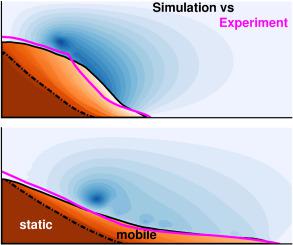Journal of Non-Newtonian Fluid Mechanics ( IF 2.7 ) Pub Date : 2021-03-20 , DOI: 10.1016/j.jnnfm.2021.104529 L. Chupin , T. Dubois , M. Phan , O. Roche

|
Numerical simulations, performed with a new two-phase bi-projection scheme, of the collapse of columns of glass beads with aspect ratios equal to 0.7 and 2 over a horizontal plane are reported and comparison with experiments are presented. A level-set formulation for the Navier–Stokes equations is used, so that the interface between the granular material and the ambient air is tracked. The granular flow is modeled with a viscoplastic rheology, derived from the –rheology, resulting in a Drucker–Prager plasticity criterion combined with a spatio-temporal variable viscosity depending on the pressure and on the shear rate. The computational effort is reduced by using instead a constant viscosity. The dependence of the results upon the value of the constant viscosity, which has been reduced by two orders of magnitude, is very weak suggesting that these granular flows are mainly governed by the Drucker–Prager plasticity criterion. The rheology is formulated as a projection, allowing for an efficient computation of the plastic part of the stress tensor. Coulomb friction conditions are applied on the walls. The dynamics of the collapse and the morphology of the final deposit are accurately reproduced. Sensitivity of the results, with respect to the resolution and the basal friction coefficient, is also studied. During the collapse, the granular material consists of a basal deposit overlain by a flowing layer, which are separated by an interface that migrates upwards until the flowing layer is consumed. The time evolution of this static-mobile interface is quantified and a good agreement is found with experiments. To the best of our knowledge this is the first simulation of internal flow dynamics validated by experiments. We also report results obtained with a viscoplastic model where the dynamic pressure in the yield is replaced by the hydrostatic pressure, depending on the granular flow height. This model produces non-physically relevant solutions. Nevertheless, from a numerical point of view, it provides interesting and challenging test cases for two-phases viscoplastic simulations as the interface rolls up before the head of the granular mass falls on the bottom wall.
中文翻译:

颗粒流中与压力有关的阈值:数值建模和实验验证
使用新的两相双投影方案进行了数值模拟,报告了纵横比等于0.7和2的玻璃珠圆柱在水平面上的塌陷,并与实验进行了比较。使用了Navier–Stokes方程的水平集公式,以便跟踪颗粒材料与环境空气之间的界面。用粘塑性流变学对颗粒流进行建模,该流变学来源于-流变学,从而得出Drucker-Prager可塑性标准,以及时空可变粘度,具体取决于压力和剪切速率。通过使用恒定粘度来减少计算量。结果对恒定粘度值的依赖性非常小,恒定粘度值已减小了两个数量级,这表明这些颗粒状流动主要受Drucker-Prager可塑性准则支配。流变被公式化为一个投影,从而可以有效地计算应力张量的塑性部分。库仑摩擦条件适用于墙壁。塌陷的动力学和最终沉积物的形态都可以精确再现。还研究了结果相对于分辨率和基摩擦系数的敏感性。在坍塌过程中,粒状材料由被流动层覆盖的基底沉积物组成,基底沉积物被向上迁移直至流动层被消耗的界面隔开。量化了该静态移动接口的时间演变,并通过实验找到了很好的一致性。据我们所知,这是首次通过实验验证的内部流动动力学模拟。我们还报告了通过粘塑性模型获得的结果,其中取决于颗粒流动高度,将产量中的动态压力替换为静水压力。该模型产生非物理相关的解决方案。不过,从数字的角度来看,











































 京公网安备 11010802027423号
京公网安备 11010802027423号